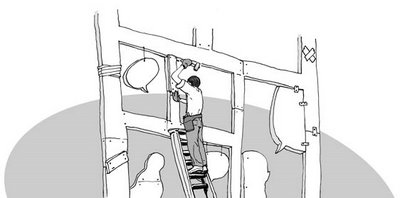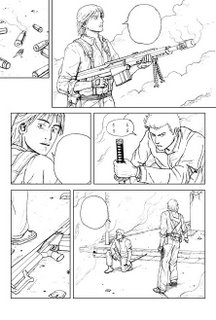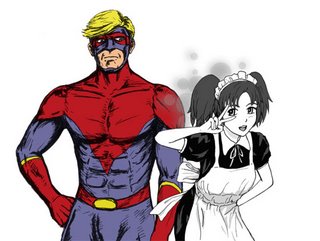
Ah! This is the longest time I ever spent on a single comic page. Anyway I finally thought of the title for it so go read the one-page comic.
Scrap blog of discarded ideas: drawings, comics, manga, sketches and thoughts.

 [click the picture to view a larger version]
[click the picture to view a larger version] [click the pictures to view a larger version]
[click the pictures to view a larger version] I use standard A4 paper (a format that’s only a little longer than Letter in the U.S.A) for my comics. The only thing that I am particular about is the whiteness of the paper; the whiter it is the better it’ll be for scanning the artwork on it which I will touch on later.
I use standard A4 paper (a format that’s only a little longer than Letter in the U.S.A) for my comics. The only thing that I am particular about is the whiteness of the paper; the whiter it is the better it’ll be for scanning the artwork on it which I will touch on later. I pencil exactly like I sketch, all hairy and messy, so it’s no surprise that the eraser is my best friend. The pencil types I use are 2H wooden pencils since they are light enough to not leave too much lead traces after erasing. I don’t like using mechanical ones for no apparent reason. As for erasers I prefer the soft rectangular kind and any make will do.
I pencil exactly like I sketch, all hairy and messy, so it’s no surprise that the eraser is my best friend. The pencil types I use are 2H wooden pencils since they are light enough to not leave too much lead traces after erasing. I don’t like using mechanical ones for no apparent reason. As for erasers I prefer the soft rectangular kind and any make will do. Having completed the penciling of every page of the comic, it’s time to ink them. Even though inking is a fairly easy process of tracing over the pencil lines I still make mistakes like drawing the lines too thick or smudging the ink due to my being left-handed. I don’t use whiteout or white paint to correct those mistakes, I’ll leave them as they are and fix them later on the computer.
Having completed the penciling of every page of the comic, it’s time to ink them. Even though inking is a fairly easy process of tracing over the pencil lines I still make mistakes like drawing the lines too thick or smudging the ink due to my being left-handed. I don’t use whiteout or white paint to correct those mistakes, I’ll leave them as they are and fix them later on the computer. [click the pictures to view a larger version]
[click the pictures to view a larger version] Should I draw the character from the side or from behind? Is it better to draw a close-up of the characters or a panoramic view of the surroundings? With so many possibilities to illustrate a scene in a panel, and having to keep in mind to maintain the continuance of the scene from the last panel, it’s almost a constant battle to arrive at a decision. When I’m finally done I’ll have to repeat the whole decision process again for the following panel. So it’s no surprise that I find storyboarding a time consuming struggle, but it’s unavoidable since it’s such a crucial step to creating comics.
Should I draw the character from the side or from behind? Is it better to draw a close-up of the characters or a panoramic view of the surroundings? With so many possibilities to illustrate a scene in a panel, and having to keep in mind to maintain the continuance of the scene from the last panel, it’s almost a constant battle to arrive at a decision. When I’m finally done I’ll have to repeat the whole decision process again for the following panel. So it’s no surprise that I find storyboarding a time consuming struggle, but it’s unavoidable since it’s such a crucial step to creating comics. Based on the storyboard I write the comic’s dialogue in the form of a script for each character in each panel as needed. Good dialogue is crucial to giving life to the comic’s characters by making them believable so that the reader is able to relate to them. I use pointers, such as the character’s personality, relationship with other characters, emotional states and reaction to events, to help me think of what they say and how they say it.
Based on the storyboard I write the comic’s dialogue in the form of a script for each character in each panel as needed. Good dialogue is crucial to giving life to the comic’s characters by making them believable so that the reader is able to relate to them. I use pointers, such as the character’s personality, relationship with other characters, emotional states and reaction to events, to help me think of what they say and how they say it. I think most comic creators design their comic’s characters at an earlier phase and in more detail than I do. Somehow I prefer to leave character design until the last part of the planning process. I don’t do detailed visual profiles like full body front views, side views and such. I usually only do headshot sketches of a character to work out his or her unique features to portray their personality. I would also create a personal back story of the character to help me envision their typical postures and how they would visually react to situations.
I think most comic creators design their comic’s characters at an earlier phase and in more detail than I do. Somehow I prefer to leave character design until the last part of the planning process. I don’t do detailed visual profiles like full body front views, side views and such. I usually only do headshot sketches of a character to work out his or her unique features to portray their personality. I would also create a personal back story of the character to help me envision their typical postures and how they would visually react to situations. I first started my foray into comics with the likes of Marvel and DC superhero comic books. When American comic publishes started bringing in translated manga such as Akira and Appleseed I found myself gravitating towards these comics from the Far-East and neglected to collect my monthly issues of The Uncanny X-men.
I first started my foray into comics with the likes of Marvel and DC superhero comic books. When American comic publishes started bringing in translated manga such as Akira and Appleseed I found myself gravitating towards these comics from the Far-East and neglected to collect my monthly issues of The Uncanny X-men. How I'm learning to make comics: part 1
How I'm learning to make comics: part 1